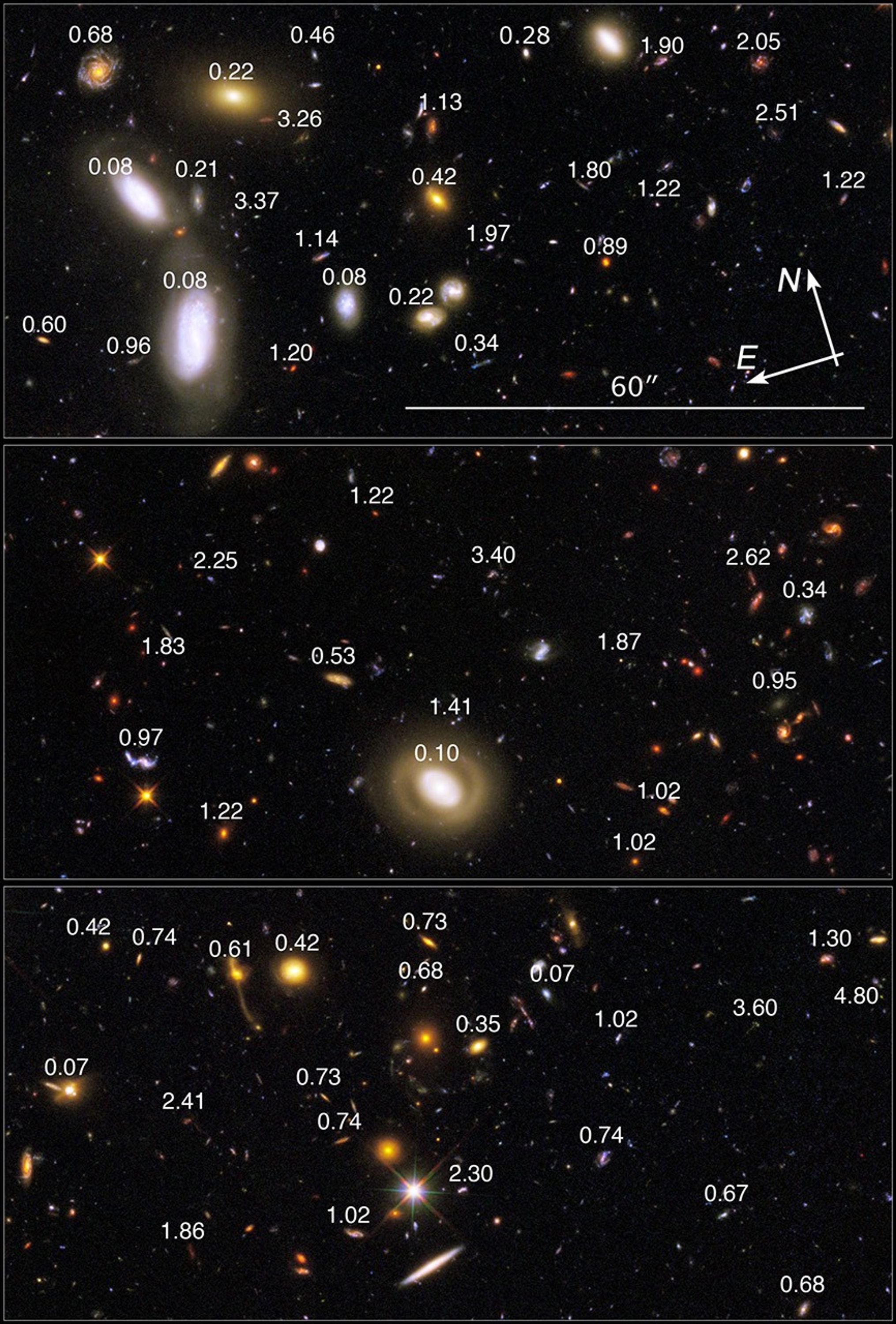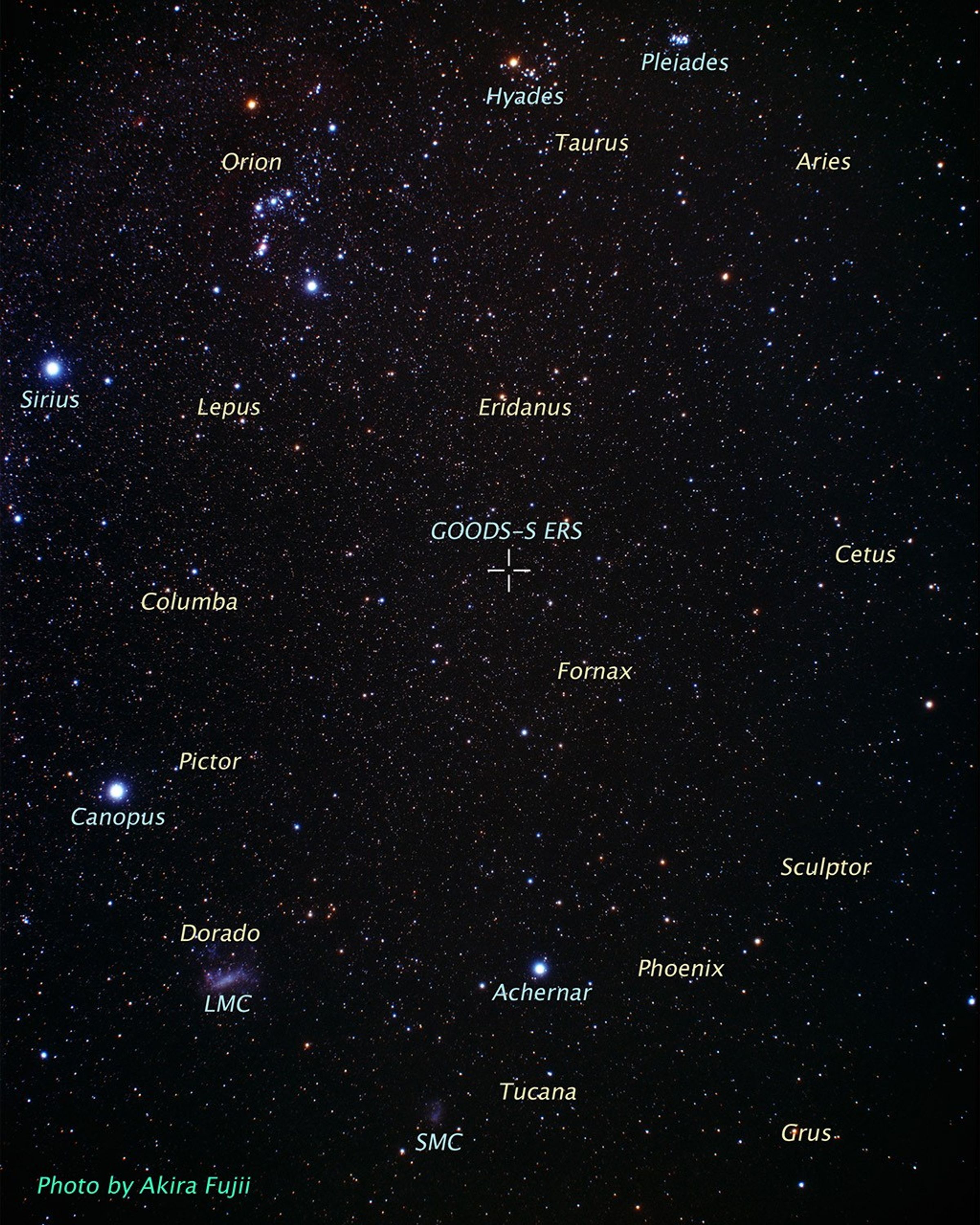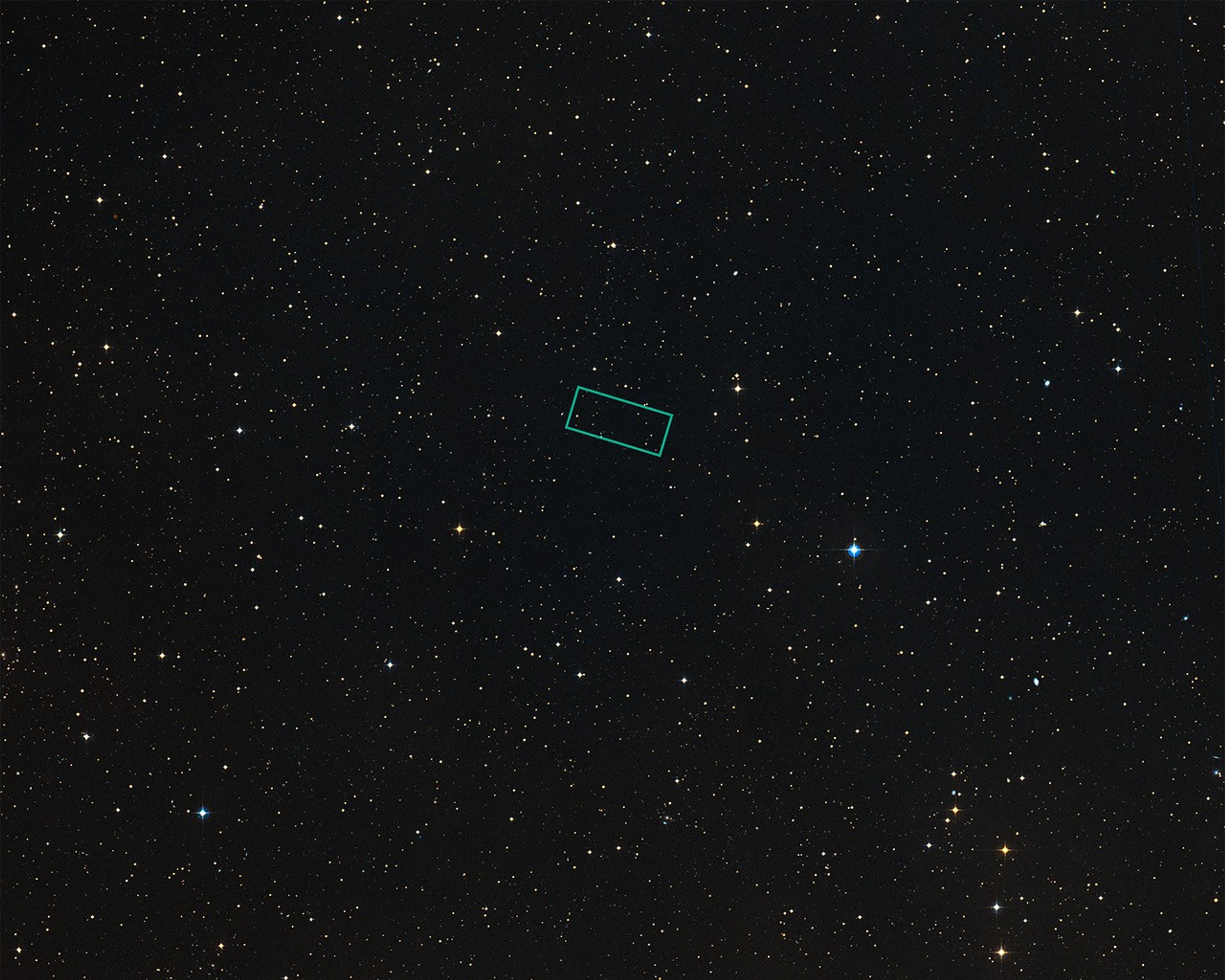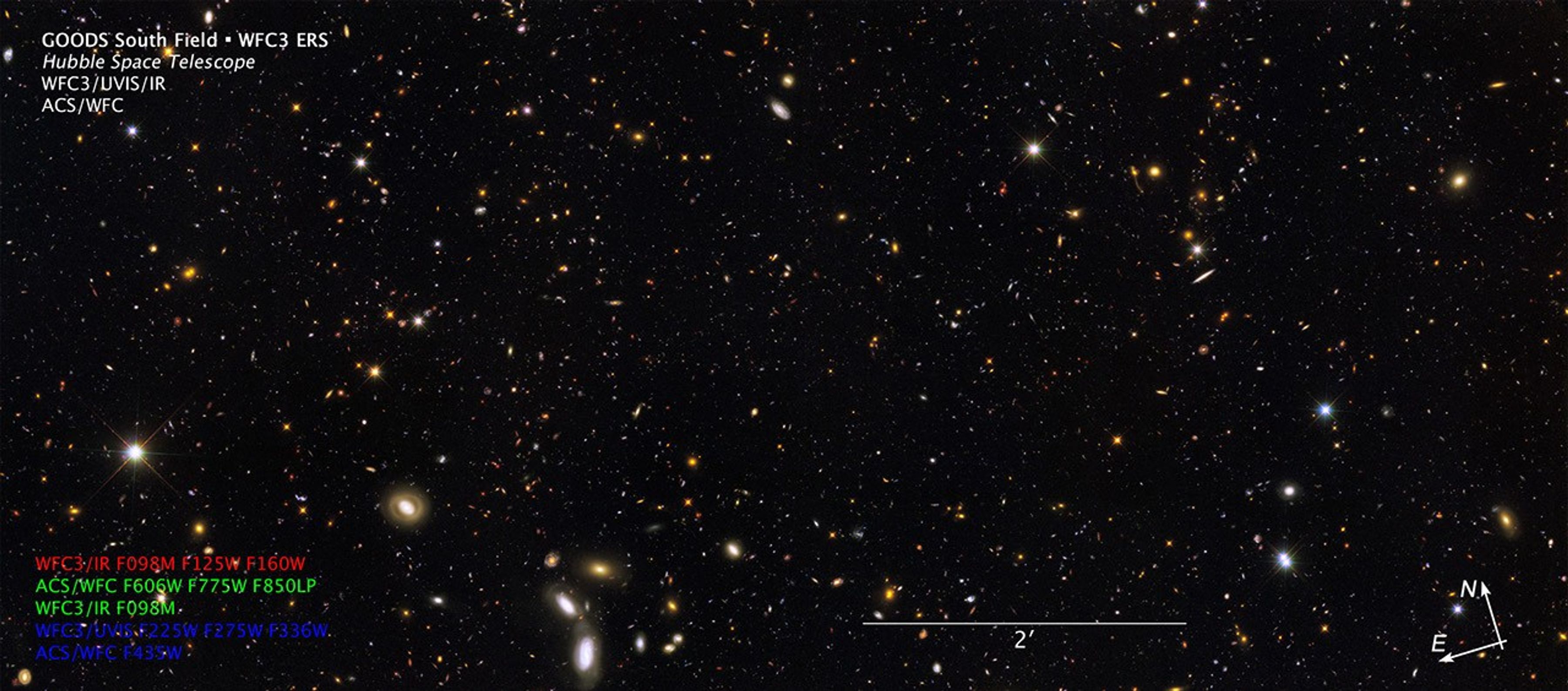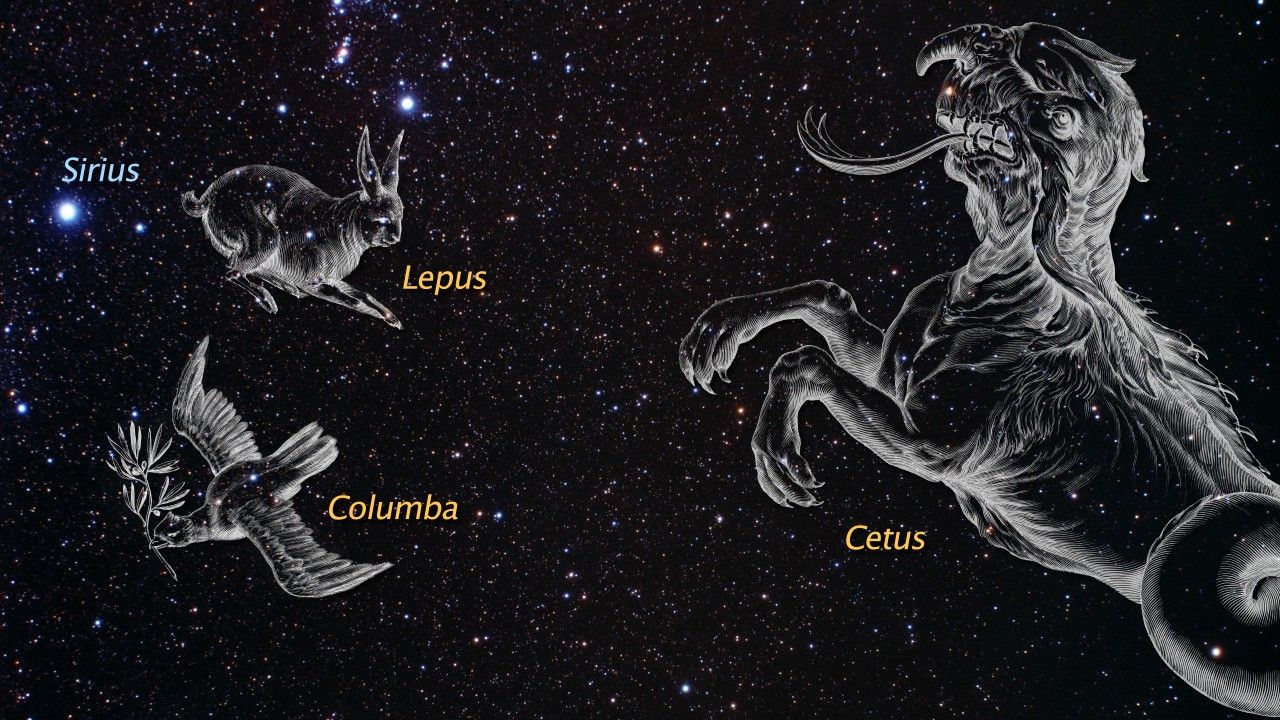1 min read
GOODS/ERS2 Field

More than 12 billion years of cosmic history are shown in this unprecedented, panoramic, full-color view of thousands of galaxies in various stages of assembly.
This image, taken by NASA's Hubble Space Telescope, was made from mosaics taken in September and October 2009 with the newly installed Wide Field Camera 3 (WFC3) and in 2004 with the Advanced Camera for Surveys (ACS). The view covers a portion of the southern field of a large galaxy census called the Great Observatories Origins Deep Survey (GOODS), a deep-sky study by several observatories to trace the formation and evolution of galaxies.
The final image combines a broad range of colors, from the ultraviolet, through visible light, and into the near-infrared. Such a detailed multi-color view of the universe has never before been assembled in such a combination of color, clarity, accuracy, and depth.
Hubble's sharp resolution and new color versatility, produced by combining data from the two cameras, are allowing astronomers to sort out the various stages of galaxy formation. The image reveals galaxy shapes that appear increasingly chaotic at each earlier epoch, as galaxies grew through accretion, collisions, and mergers. The galaxies range from the mature spirals and ellipticals in the foreground, to smaller, fainter, irregularly shaped galaxies, most of which are farther away, and therefore existed farther back in time. These smaller galaxies are considered the building blocks of the larger galaxies we see today.
Astronomers are using this multi-color panorama to trace many details of galaxy assembly over cosmic time, including the star-formation rate in galaxies, the rate of mergers among galaxies, and the abundance of weak active galactic nuclei.
The image shows a rich tapestry of 7,500 galaxies stretching back through most of the universe's history. The closest galaxies seen in the foreground emitted their observed light about a billion years ago. The farthest galaxies, a few of the very faint red specks, are seen as they appeared more than 13 billion years ago, or roughly 650 million years after the Big Bang. This mosaic spans a slice of space that is equal to about a third of the diameter of the full Moon (10 arcminutes).
The new Hubble view highlights a wide variety of stages in the galaxy assembly process. Ultraviolet light taken by WFC3 shows the blue glow of hot, young stars in galaxies teeming with star birth. The orange light reveals the final buildup of massive galaxies about 8 billion to 10 billion years ago. The near-infrared light displays the red glow of very distant galaxies – in a few cases as far as 12 billion to 13 billion light-years away – whose light has been stretched, like a toy Slinky, from ultraviolet light to longer-wavelength infrared light due to the expansion of the universe.
In this ambitious use of Hubble's observing time, astronomers used 96 Hubble orbits to make the ACS optical observations of this slice of the GOODS field and 104 orbits to make the WFC3 ultraviolet and near-infrared exposures. WFC3 peered deeper into the universe in this study than comparable near-infrared observations from ground-based telescopes. This set of unique new Hubble observations reveals galaxies to about 27th magnitude in brightness over a factor of 10 in wavelength. That's over 250 million times fainter than the unaided eye can see in visual light from a dark ground-based site.
About the Object
- R.A. PositionR.A. PositionRight ascension – analogous to longitude – is one component of an object's position.03h 32m 40.23s
- Dec. PositionDec. PositionDeclination – analogous to latitude – is one component of an object's position.-27° 43' 9.86"
- ConstellationConstellationOne of 88 recognized regions of the celestial sphere in which the object appears.Fornax
- DimensionsDimensionsThe physical size of the object or the apparent angle it subtends on the sky.This image is approximately 9.68 arcminutes wide by 4.27 arcminutes high.
About the Data
- Data DescriptionData DescriptionProposal: A description of the observations, their scientific justification, and the links to the data available in the science archive.
Science Team: The astronomers who planned the observations and analyzed the data. "PI" refers to the Principal Investigator. - InstrumentInstrumentThe science instrument used to produce the data.HST>ACS/WFC, HST>WFC3/UVIS, and HST>WFC3/IR
- Exposure DatesExposure DatesThe date(s) that the telescope made its observations and the total exposure time.Sept. 2002 - Dec. 2004, Exposure Time: 96 orbits (ACS) and Sept. 6, 2009 - Oct. 11, 2009, Exposure Time: 104 orbits (WFC3)
- FiltersFiltersThe camera filters that were used in the science observations.WFC3/IR: F098M, F125W, and F160W ACS/WFC: F435W, F606W, F775W, and F850LP WFC3/UVIS: F225W, F275W, and F336W
- Object NameObject NameA name or catalog number that astronomers use to identify an astronomical object.GOODS-S/ERS, GOODS South Field WFC3 Early Release Science Data (GOODS-S WFC3 ERS), Chandra Deep Field South (CDF-S)
- Object DescriptionObject DescriptionThe type of astronomical object.Cosmological Survey
- Release DateJanuary 5, 2010
- Science ReleaseGalaxy History Revealed in This Colorful Hubble View
- CreditNASA, ESA, R. Windhorst, S. Cohen, M. Mechtley, and M. Rutkowski (Arizona State University, Tempe), R. O'Connell (University of Virginia), P. McCarthy (Carnegie Observatories), N. Hathi (University of California, Riverside), R. Ryan (University of California, Davis), H. Yan (Ohio State University), and A. Koekemoer (Space Telescope Science Institute)

The image is a composite of separate exposures made by the WFC3 and ACS instruments on the Hubble Space Telescope. In total, 10 filters were used to sample a very wide wavelength range. The color results from assigning different hues (colors) to combinations of the monochromatic images. In this case, the assigned colors are: Red: WFC3/IR F125W + F160W Green: ACS/WFC F606W + F775W + F850LP + WFC3/IR F098M Blue: WFC3/UVIS F225W + F275W + F336W + ACS/WFC F435W

Related Images & Videos
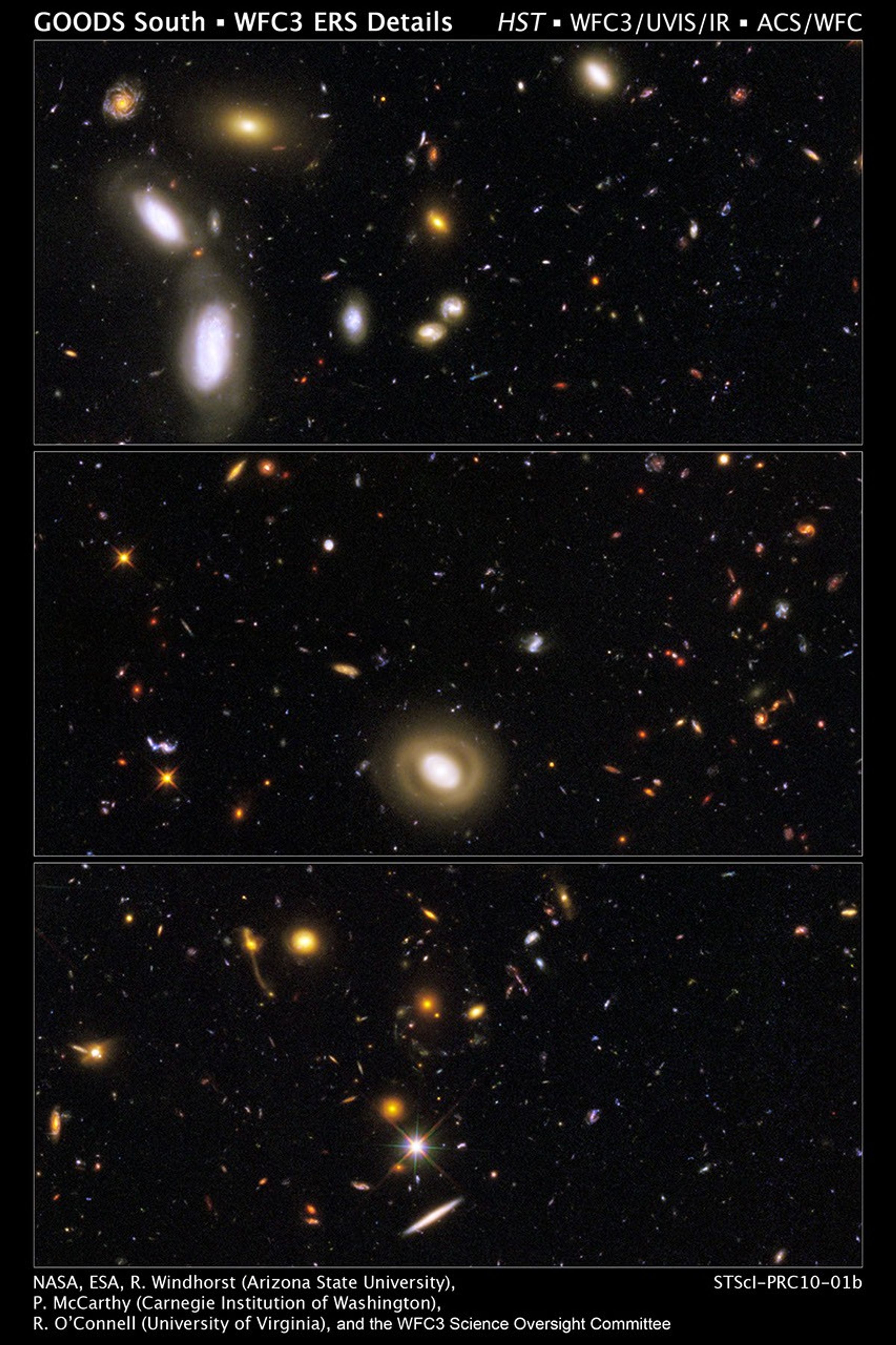
Close-Up Views of the GOODS Field
These three close-up views show the rich variety of galaxies that appear in the new panoramic, full-color image of the Great Observatories Origins Deep Survey (GOODS) field, taken by NASA's Hubble Space Telescope. The full field reveals 7,500 galaxies in various stages of...
Share
Details
Claire Andreoli
NASA’s Goddard Space Flight Center
Greenbelt, Maryland
claire.andreoli@nasa.gov






























